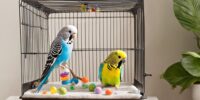How to Create a Suitable Habitat for Canary-Winged Parakeets
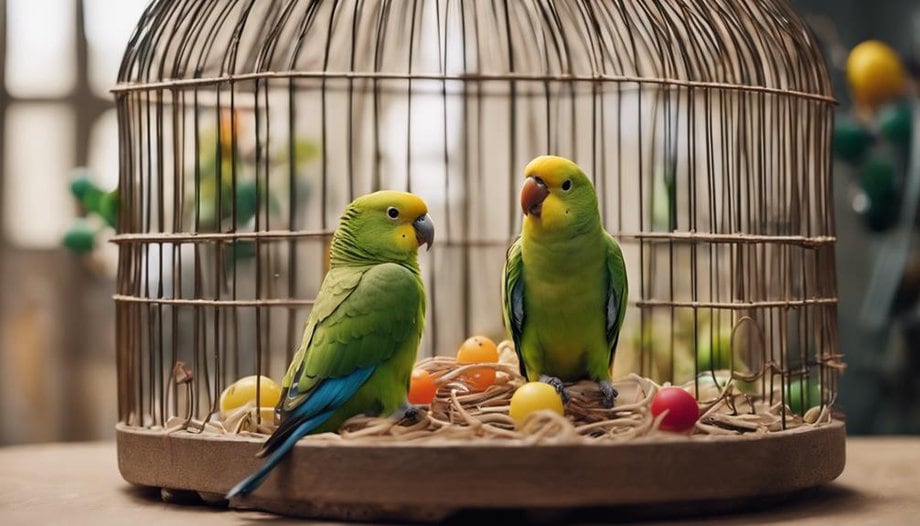
Canary-winged parakeets, also known as yellow-chevroned parakeets, require a carefully designed habitat to thrive in captivity. Beyond the basic cage setup, several key factors contribute to creating a suitable environment for these active and social birds.
Providing ample space for flight and exercise is essential for canary-winged parakeets' physical and mental well-being. A spacious aviary or a large cage with horizontal space for flying will help mimic their natural habitat and prevent boredom and stress.
Ensuring a varied and balanced diet is crucial for the overall health of canary-winged parakeets. Their diet should include a mix of high-quality seeds, fresh fruits, vegetables, and occasional treats. It's also important to provide clean, fresh water daily to keep them hydrated.
Social interaction and mental stimulation are vital for canary-winged parakeets' happiness. These birds are highly social and thrive on companionship, so they should ideally be kept in pairs or small groups. Additionally, providing toys, perches, and regular out-of-cage time for play and exploration will help keep them engaged and entertained.
Maintaining a clean environment is essential for the health of canary-winged parakeets. Regularly clean their cage or aviary, replacing bedding, and providing fresh food and water daily. Monitoring their health and behavior closely will also help detect any potential issues early on.
By considering these key factors beyond the cage setup, you can create a suitable habitat that meets the physical, social, and mental needs of canary-winged parakeets in captivity.
Cage Size and Shape
To provide adequate living space for canary-winged parakeets, consider a cage that's at least three feet wide, two feet deep, and four feet tall. This size allows the birds ample room to move, stretch their wings, and engage in natural behaviors. Cage ventilation is crucial for the health of the parakeets, as it helps maintain air quality and regulate humidity levels. Ensuring proper lighting within the cage is also essential. Natural light is beneficial, but supplemental full-spectrum lighting can be used to mimic the effects of sunlight, promoting the birds' overall well-being.
Cage enrichment plays a significant role in keeping canary-winged parakeets mentally and physically stimulated. Accessories such as perches of varying sizes and textures, swings, ladders, and interactive toys provide opportunities for exercise and mental engagement. These additions help prevent boredom and encourage natural behaviors like climbing, chewing, and playing. When selecting cage accessories, opt for safe materials and regularly clean and rotate items to maintain a stimulating environment for the birds.
Optimal Cage Location
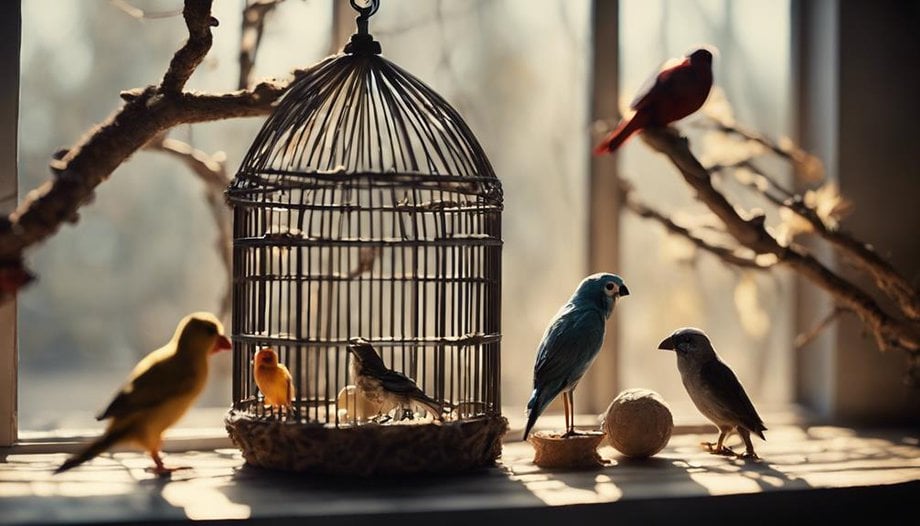
Proper placement of the cage for canary-winged parakeets is crucial to ensure their well-being and comfort in captivity. When selecting the optimal location for the cage, several factors must be taken into consideration to provide a suitable environment for these birds.
- Cage Ventilation: Ensure the cage is placed in an area with adequate airflow to maintain fresh air circulation and prevent the buildup of harmful fumes.
- Natural Lighting: Position the cage in a spot that allows for exposure to natural light, which is beneficial for the birds' overall health and well-being.
- Temperature Regulation: Place the cage away from direct drafts or sources of heat to maintain a stable and comfortable temperature for the parakeets.
- Noise Level: Select a location that's quiet and free from loud noises to prevent stress and disturbance to the birds.
- Visibility: Position the cage at eye level to allow for easy monitoring and interaction with the canary-winged parakeets.
Essential Perches for Exercise
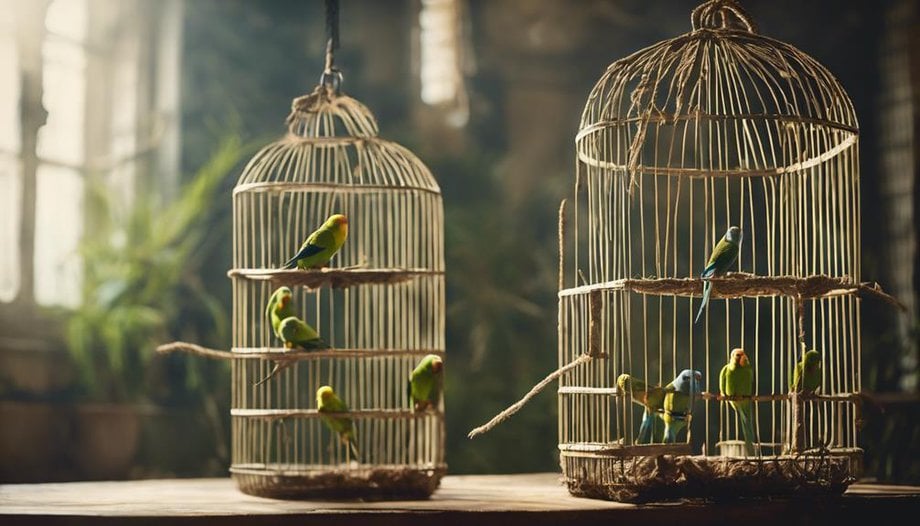
Canary-winged parakeets require varied perch sizes to exercise their feet and leg muscles effectively. Natural branch perches offer a more authentic and stimulating environment for the birds to display their natural behaviors.
Additionally, providing a swinging perch option can further encourage physical activity and mental stimulation for these active and intelligent parakeets.
Varied Perch Sizes
Varied perch sizes play a crucial role in providing canary-winged parakeets with essential exercise opportunities in their habitat. These perches not only serve as resting spots but also aid in promoting physical activity and mental stimulation. When selecting perches, it's important to consider perch enrichment and perch material to ensure the well-being of the parakeets.
- Different Diameter Perches: Varying sizes help exercise different muscles in the birds' feet.
- Rough Textured Perches: Assist in maintaining the parakeets' beak and nails.
- Swing Perches: Provide a dynamic element for balance and coordination.
- Sanded Perches: Aid in keeping the claws trimmed.
- Natural Wood Perches: Mimic the birds' natural environment and promote healthy feet.
Natural Branch Perches
Natural branch perches in a canary-winged parakeet habitat are essential for providing the birds with opportunities for exercise and physical stimulation. Bark perches offer a natural look, mimicking the birds' wild environment and promoting their natural behaviors. Tree branches not only serve as perches but also contribute to environmental enrichment, keeping the parakeets mentally stimulated and physically active. These perches vary in diameter, textures, and heights, offering the birds a diverse range of options for movement and play. By incorporating a combination of bark perches and tree branches, caregivers can create a dynamic and engaging habitat that supports the well-being of their canary-winged parakeets.
| Bark Perches | Tree Branches | Environmental Enrichment |
|---|---|---|
| Natural look | Varied heights | Mental stimulation |
| Textured surface | Different diameters | Physical activity |
Swinging Perch Option
Swinging perches provide canary-winged parakeets with an essential opportunity for exercise and physical stimulation in their habitat. These perches offer numerous benefits for the birds' well-being:
- Swinging perch benefits: They encourage natural movement and help strengthen leg muscles.
- DIY options: Owners can create swinging perches using safe materials like untreated wood or bird-safe ropes.
- Safety first: Ensure the perch is securely attached to prevent accidents or injuries.
- Training tips: Introduce the swinging perch gradually, allowing the parakeets to become comfortable with it.
- Supervision: Monitor the birds initially to ensure they're using the swinging perch safely and confidently.
Providing a Balanced Diet
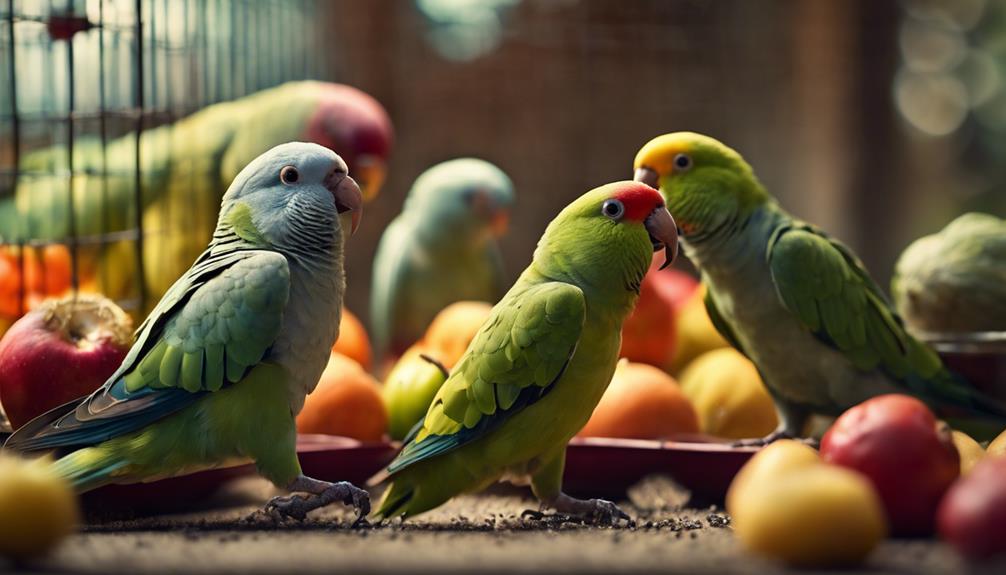
To ensure optimal health and well-being, canary-winged parakeets require a diverse array of nutrient-rich foods in their diet. Achieving nutritional balance is key to their overall wellness. A balanced diet for canary-winged parakeets should consist of high-quality pellets as the mainstay, supplemented with fresh fruits and vegetables. Including dietary supplements like calcium and vitamin D can further enhance their health.
In the wild, canary-winged parakeets engage in food foraging activities that provide mental stimulation. To mimic this behavior in captivity, owners can offer food puzzles or scatter food around the cage for the parakeets to find. This not only keeps them physically active but also mentally engaged, promoting their overall well-being.
Safe and Stimulating Toys
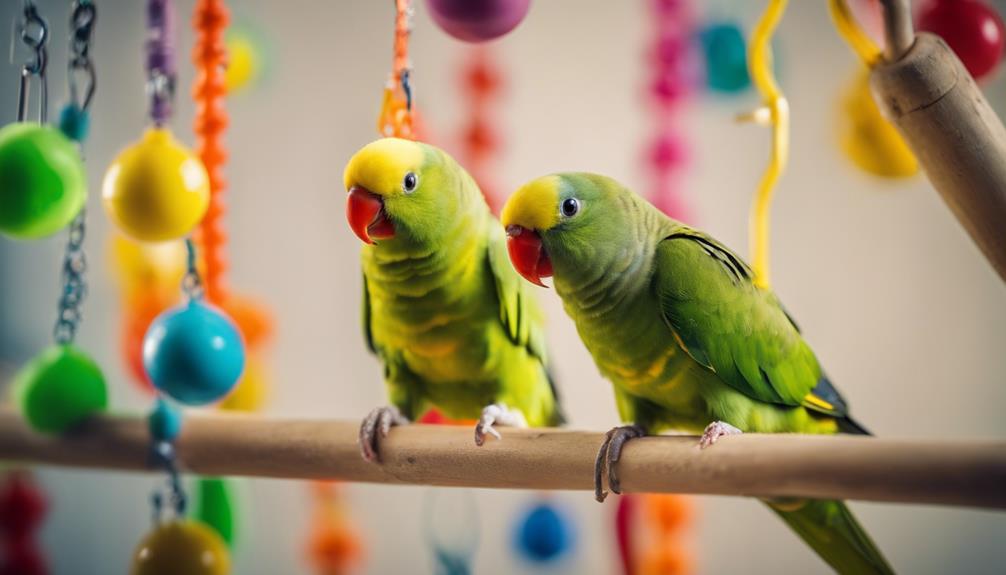
Owners can enhance the well-being of their canary-winged parakeets by providing safe and stimulating toys that encourage physical activity and mental engagement. Interactive enrichment is crucial to keep these intelligent birds mentally stimulated and physically active. Here are some safe and stimulating toys that can be beneficial for canary-winged parakeets:
- Puzzle Feeders: These toys provide mental stimulation as the birds have to figure out how to access their food, mimicking natural foraging behaviors.
- Swings and Perches: Offering a variety of perch sizes and textures can help promote foot health and provide exercise opportunities.
- Chew Toys: Providing safe chew toys made of bird-proof materials can help satisfy the parakeets' natural urge to chew.
- Mirrors and Bells: These toys can provide visual and auditory stimulation, keeping the birds engaged and entertained.
- Climbing Structures: Adding ladders or ropes can encourage physical activity and provide opportunities for exercise.
Additionally, bird-proofing accessories should be used to ensure that the toys are safe and secure within the cage, minimizing the risk of accidents.
Proper Maintenance and Cleaning
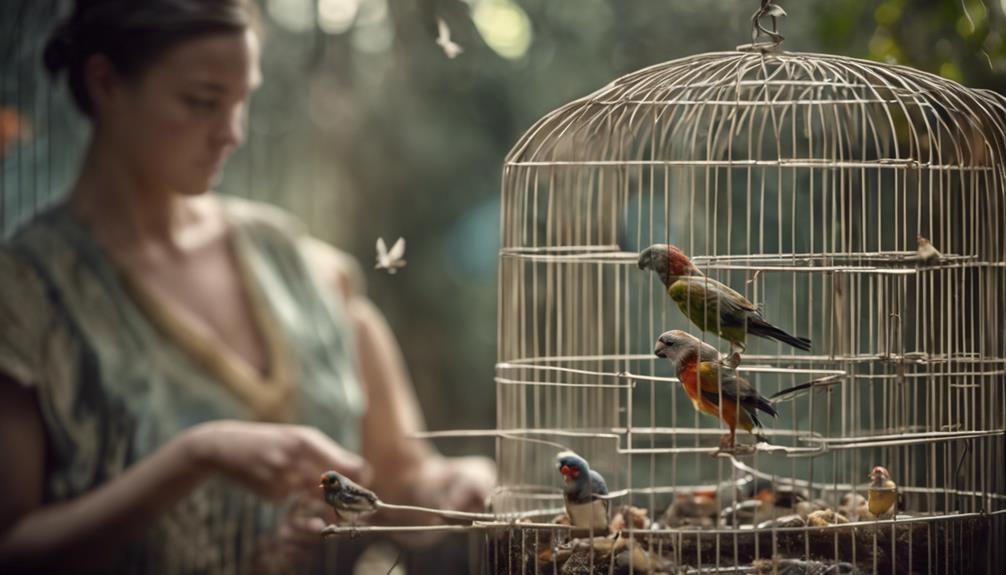
Regular cage cleaning is crucial to maintaining a healthy environment for canary-winged parakeets.
Proper disinfection methods should be employed to prevent the spread of harmful bacteria and diseases.
These practices are essential for the well-being and longevity of the birds.
Regular Cage Cleaning
Proper maintenance and cleaning of the canary-winged parakeet's cage is essential for ensuring a healthy and hygienic environment for the bird. Regular cleaning and disinfection help prevent the buildup of bacteria and parasites, ensuring the well-being of your feathered friend. Here are some key points to consider:
- Cleaning Frequency: Regularly remove droppings and leftover food daily. Deep clean the cage and accessories weekly.
- Disinfection: Use pet-safe disinfectants to clean the cage thoroughly, ensuring all surfaces are disinfected.
- Cage Accessories: Wash and rotate toys, perches, and dishes to prevent contamination.
- Playtime: Allow your parakeet supervised playtime outside the cage in a safe environment.
- Monitoring: Keep an eye out for any signs of illness or distress in your bird during cleaning routines.
Safe Disinfection Methods
Maintaining a hygienic environment for canary-winged parakeets involves employing safe and effective disinfection methods to ensure the cleanliness of their living space. When it comes to disinfecting their habitat, using non-toxic cleaners is crucial to prevent harm to the birds.
Safe disinfection products such as diluted white vinegar or hydrogen peroxide can be effective in killing bacteria and viruses while being gentle on the birds' sensitive respiratory systems. It's essential to thoroughly clean perches, toys, food and water containers regularly with these safe disinfection products to prevent the spread of harmful pathogens.
Additionally, ensuring proper ventilation and allowing surfaces to dry completely after cleaning are important tips to maintain a healthy environment for canary-winged parakeets.
Monitoring Health and Behavior
Monitoring the health and behavior of canary-winged parakeets is crucial for ensuring their well-being in captivity. By regularly observing and assessing their physical condition and actions, caretakers can promptly address any issues that may arise.
Here are some key points to consider when monitoring the health and behavior of canary-winged parakeets:
- Behavior Monitoring: Pay close attention to changes in their usual behavior patterns, such as increased aggression, lethargy, or unusual vocalizations.
- Health Checks: Regularly conduct physical examinations to check for signs of illness, injury, or abnormalities in their feathers, eyes, and beak.
- Interaction Cues: Observe how the parakeets interact with each other and their environment to ensure they're comfortable and stress-free.
- Socialization Techniques: Implement socialization strategies to help the parakeets feel secure and build trust with their caretakers.
- Training Methods: Use positive reinforcement techniques to train the parakeets and strengthen the bond between them and their human companions.
Frequently Asked Questions
Can Canary-Winged Parakeets Be Housed With Other Bird Species?
While some bird species can coexist harmoniously, behavior compatibility and socialization are crucial when considering housing canary-winged parakeets with other species. Proper aviary design and adequate space requirements must be met to ensure their well-being.
How Often Should I Replace the Perches in the Cage?
In a suitable habitat for canary-winged parakeets, replacing perches is crucial for cage cleanliness. Proper perch size ensures the birds can rest comfortably and exercise. Regularly changing perches also helps prevent foot problems and maintains a healthy environment.
Are There Any Specific Plants or Natural Elements That Can Be Added to the Habitat?
Ironically, one might assume that canary-winged parakeets prefer a minimalist habitat. However, by incorporating natural enrichment like leafy branches, wooden perches, and playful interactions with hanging toys, the parakeets thrive in a more dynamic environment.
How Can I Tell if My Canary-Winged Parakeet Is Stressed or Unhappy in Its Environment?
Canary-winged parakeets may exhibit stress indicators like excessive vocalization, feather plucking, or aggression when unhappy. Behavioral changes such as decreased appetite or listlessness can also signify distress. Providing environmental enrichment and mental stimulation can help alleviate these issues.
Are There Any Specific Training Techniques or Methods for Creating a Bond With My Canary-Winged Parakeet?
When looking to bond with canary-winged parakeets, utilizing positive reinforcement and socialization is key. By observing their behavioral cues and body language, individuals can tailor their approach to build a trusting and interactive relationship with these birds.



